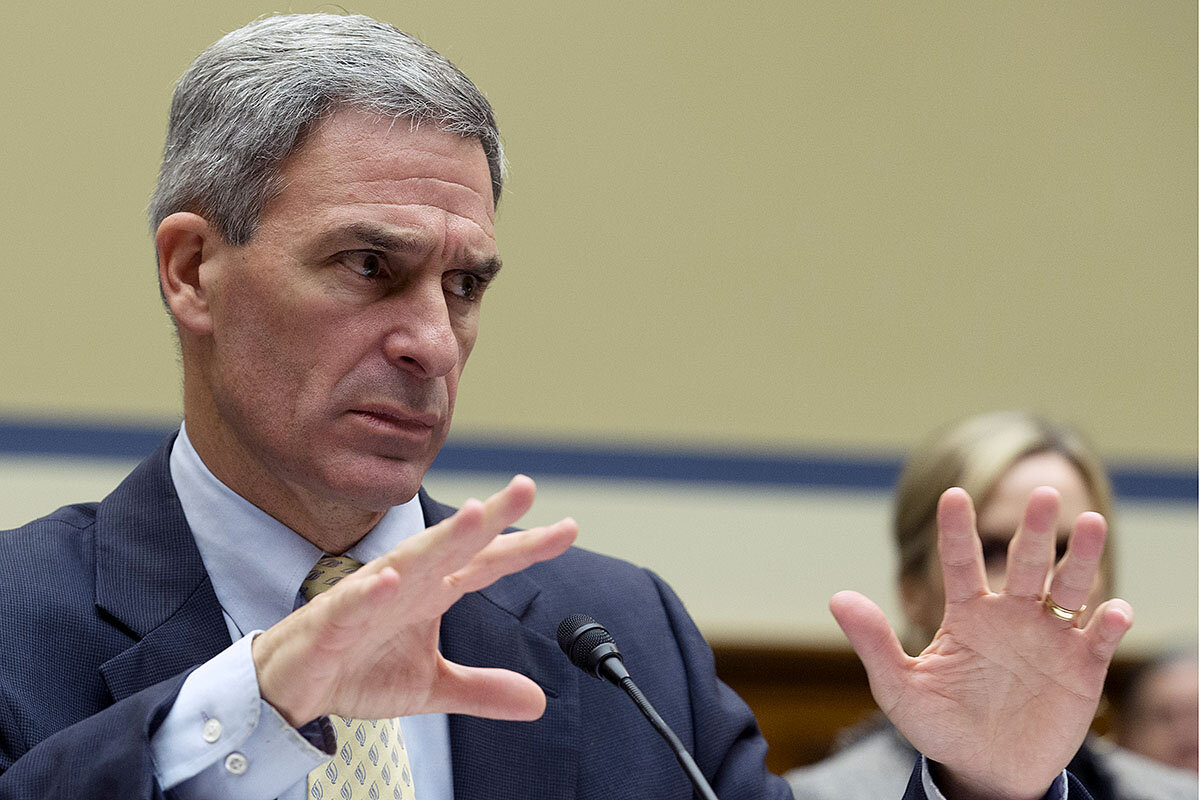How coronavirus offers stress test of Trump’s management
Loading...
On Monday, acting Deputy Secretary of Homeland Security Ken Cuccinelli took to Twitter to ask for help with some research.
Mr. Cuccinelli – the top member of President Donald Trump’s coronavirus task force – was having difficulty accessing an online map of the virus’s spread compiled by Johns Hopkins University in Baltimore. So he : Was the map blocked for other people, too, or just him?
In the end it appeared overwhelming traffic had temporarily crashed the Hopkins site. Hours later Mr. Cuccinelli tweeted he had access to the data. But for critics, the original question, from a top official with all the resources of the United States government at his fingertips, was itself a warning sign of the confusion and turmoil inherent in the Trump administration’s singular approach to bureaucratic staffing.
Why We Wrote This
Republicans tend to like small government. But President Trump’s approach of leaving posts vacant and favoring loyalty over experience may be undermining his ability to get things done.
Three years into the Trump presidency, perceived loyalty to the president is perhaps the job qualification prized above all. Top White House and executive branch officials seem unsure of their status, vacancies are numerous, and inexperienced “acting” personnel are common.
Currently this approach is particularly visible in the area of national security. Almost all the positions created after Sept. 11, 2001, intended to help prevent another 9/11, are now vacant or lack permanent appointees, . That includes the director of national intelligence, the secretary of homeland security, the deputy secretary of homeland security, the director of the National Counterterrorism Center, and heads of border security agencies.
It’s true that presidents deserve their own team, says Matt Glassman, a senior fellow at the Government Affairs Institute at Georgetown University. Political purges of the bureaucracy aren’t uncommon.
But some of President Trump’s methods weaken his ability to get the executive branch to work his will, says Dr. Glassman, an expert on government leadership and personnel. Vacant jobs can’t steer anybody. “Acting” officials are weaker than Senate-confirmed appointees.
“Acting officials are like substitute teachers. They might listen to the principal more, but they can’t control the students,” according to Dr. Glassman.
The shuffle at the top of the Office of the Director of National Intelligence has brought administration staffing back into the spotlight. Earlier this month, President Trump removed one acting director of national intelligence, Joseph Maguire, and replaced him with another deemed more loyal, Richard Grenell.
The swap followed reports that an intelligence official had briefed the House Intelligence Committee on an assessment that Russia is working to influence the 2020 election, and in particular wants President Trump to be reelected. (Later reports said that Russia backs Bernie Sanders for the Democratic nomination as well.)
Current acting Director of National Intelligence Grenell is serving concurrently as ambassador to Germany. Such dual hatting is not uncommon in the Trump administration. Acting Deputy Secretary of Homeland Security Cuccinelli, after his appointment to the job last November, continued to serve as acting director of the U.S. Citizenship and Immigration Services.
Meanwhile, Johnny McEntee, a former personal aide to President Trump who was fired by former chief of staff John Kelly over security clearance issues, has returned to the White House as head of the Presidential Personnel Office. Mr. McEntee’s assignment is to rid the administration of officials deemed disloyal and replace them with pro-Trump people, according to an Axios report.
Overall, the turnover for the “A” team of Cabinet officials and other top appointees in the first three years of the Trump administration has been 82%, according to data compiled by the Brookings Institution’s Kathryn Dunn Tenpas. That is higher than the turnover experienced in the first four years of any presidency, back to and including that of Ronald Reagan.
Furthermore, that number reflects just departures from the president’s original team. Many jobs – chief of staff, press secretary – have seen multiple departures. According to Brookings data, 38% of President Trump’s “A” team departures have undergone serial turnover.
The administration’s filling of top positions has improved since the president’s first year in office, when many remained vacant for months. A cumulative list compiled by The Washington Post says that of 743 key positions requiring Senate confirmation, 508 are now filled by confirmed personnel. One hundred seventy have no nominee.
In the American system of government as outlined under the Constitution, executive branch officials, including, and perhaps especially, Senate-confirmed top appointees, don’t report to the president alone, according to experts.
“The basic idea is when you’re an appointed official in the federal government, particularly a Senate-confirmed one, you have multiple relationships,” says Dr. Glassman of Georgetown University.
Above this layer of officials sits Congress. With their appropriations and oversight powers, and confirmation votes, lawmakers have a significant role to play in executive department activities. Effective Cabinet secretaries either know this from experience or learn it very quickly.
Below the officials sits the bureaucracy. Career workers know their subject better than any appointee can learn in a limited time in office. They know they can outlast and perhaps outmaneuver their big bosses.
Presidents can rail at the “deep state” all they want, but the fact is they cannot directly control the executive branch as they would a family business that runs hotels and golf courses – or even as they would a big corporation. The essential point of the classic work on presidential power by the late political scientist Richard Neustadt is that presidents can rarely get things done on a sustained basis by command or unilateral action. They must persuade others to do what they want.
“The most effective presidents ... are those who understand the sources of their bargaining power, and take steps to nurture those sources,” writes Matthew Dickinson, a professor of political science at Middlebury College, in a recent post on his blog Presidential Power.
This is why “acting” officials are seldom as powerful as permanent ones. They are weak links in the chain of persuasion.
President Trump has said he likes to use “acting” tags because it keeps the people in question on their toes and eager to please him. But their other important relationships are flawed. They don’t have the implicit backing of Congress provided by confirmation. The rank and file know they could be gone at any moment, and that delay is thus even a blockade tool. This is why Dr. Glassman calls them “substitute teachers.”
Overuse of these temps is a sign of weakness, he says. “If you’re really so powerful, how come you can’t get your own guy confirmed?”
For the Trump administration, the new coronavirus, now labeled COVID-19, could become an unexpected stress test of the president’s churning approach to executive management.
Early Tuesday morning President Trump tweeted, “The coronavirus is very much under control in the U.S.A.” But later in the day, the Centers for Disease Control and Prevention said that Americans should begin preparing now for possible outbreaks.
At a Senate hearing, both Democratic and Republican lawmakers expressed skepticism that the administration is ready for such a crisis. Republican Sen. John Kennedy of Louisiana pressed acting Secretary of Homeland Security Chad Wolf for an estimate of the number of people who might be affected.
Acting Secretary Wolf could not provide one.
“I think you ought to know that answer,” Senator Kennedy said.





